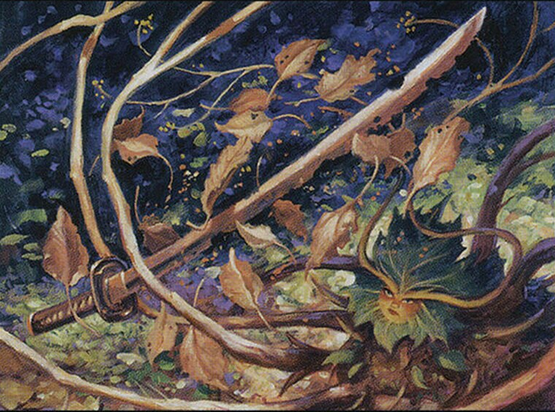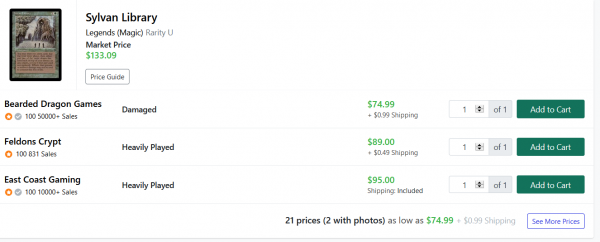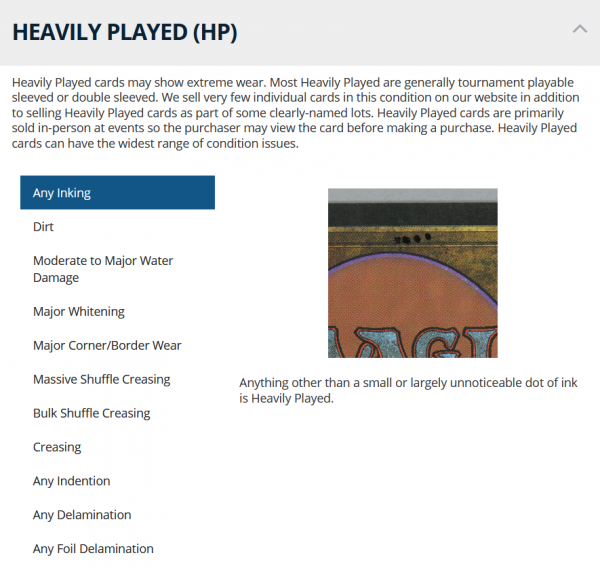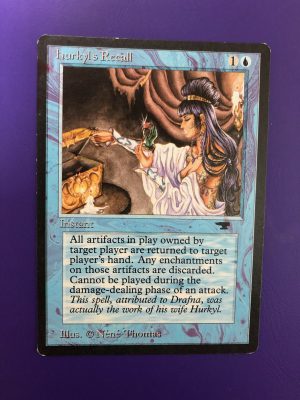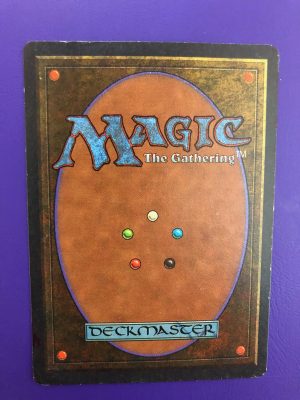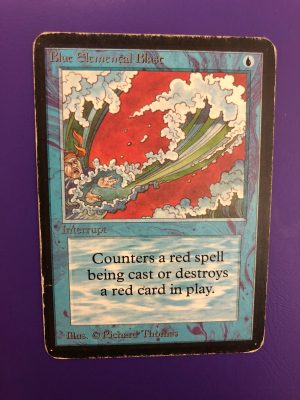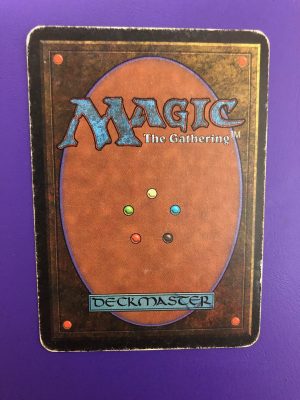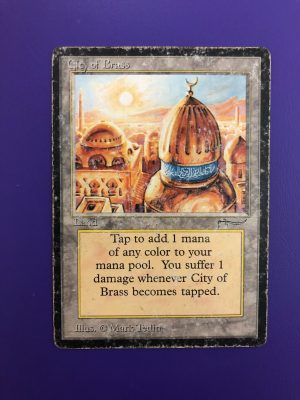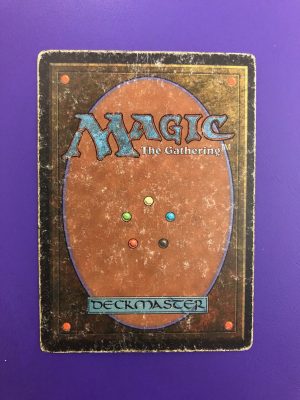Are you a Quiet Speculation member?
If not, now is a perfect time to join up! Our powerful tools, breaking-news analysis, and exclusive Discord channel will make sure you stay up to date and ahead of the curve.
I’ve seen it many times before. Usually, it’s while I’m shopping for a well-priced Old School card for a deck. Sometimes when I see a card spiked on MTG Stocks, I’ll run to TCGplayer and see it. It’s so risky, but it is difficult to ignore.
What am I talking about? Buying heavily played / damaged cards, of course!
Imagine this scenario: you’re looking for an English Legends Sylvan Library. You noticed recently that Card Kingdom’s buy price on the card keeps climbing, and then you noticed the card spiked to $223 on MTG Stocks. Despondent, you make a desperation check on TCGplayer and find the following, cheapest listings:
First off, these copies are fairly reasonable considering how high the TCG mid number is. Secondly and more importantly, you’re faced with a tough choice. Do you roll the dice on the $75 damaged copy or do you pay $15 more for the cheapest HP from a seller with far less feedback? Or do you pay yet another $5 to purchase a heavily played copy from a larger seller?
The Damaged Lottery
It can be very tempting to pay far below market price for a copy of a card you intend to play even though it’s listed on TCGplayer as “damaged”. Here’s the description for damaged cards according to TCGplayer’s Grading Guide:
“Cards in Damaged condition can exhibit a tear, bend or crease that may make the card illegal for tournament play, even in a sleeve. If more than 30% of the card is damaged by liquid, it’s considered Damaged. Cards in Damaged condition may have extreme border wear, extreme corner wear, heavy scratching or scuffing, folds, creases or tears or other damages that impact the structural integrity of the card.”
What do you make of this? Well, I’m relieved to see that TCGplayer has updated their grading guide to remove “inking and signatures” from their damaged description—they instead suggest sellers use pictures for such cards. But still, I feel like a damaged card with extreme border wear is a lot more tolerable than a card that exhibits a tear. Shuffle creases are fine if you’re looking for a budget copy to play, but a fold? That may be problematic.
As you can see, purchasing a damaged card can be very risky (hence why I describe it as “the damaged lottery”). I’ve only tried it a couple times from TCGplayer. One seller I like in particular tends to grade their cards one tier lower than I personally would—therefore, I trust their damaged cards to be on par with heavily played condition. But there’s always a chance it doesn’t break that way. Conversely, I once bought a cheap, damaged Legends Spectral Cloak and it looked like someone had dropped a pile of bricks on the card.
With TCGplayer, the large pool of sellers makes it almost impossible to identify trends and predict what you’ll receive. It truly is up to chance, like the lottery. But how about buying heavily played cards from major online vendors like Star City Games, Channel Fireball, and Card Kingdom? What are their HP lotteries like?
Major Vendors
I have a lot more experience purchasing heavily played and damaged cards from major vendors because I’m more inclined to trust they wouldn’t sell a card literally torn up. Here are the “HP” or “Damaged” descriptions from some of the major vendor’s grading guide.
Card Kingdom:
Channel Fireball:
Star City Games:
ABUGames:
There’s a lot to unpack here, and I’m not going to dive into every single characteristic by website. I think the descriptions are largely consistent. Because of all the ways a card can be deemed heavily played, it’s easier to identify that a card is heavily played than it is to define in words what that means. I’m going to take some creative license, and reference the famous quote by United States Supreme Court Justice Potter Stewart:
“I shall not today attempt further to define the kinds of material I understand to be embraced within that shorthand description [HP/Damaged cards], and perhaps I could never succeed in intelligibly doing so. But I know it when I see it…”
(If you don’t know what Justice Potter Stewart was actually referencing for this quote, please look it up and have a laugh!)
Some Personal Examples
As I mentioned before, I have become a bit of an expert in heavily played cards from major vendors because I tend to purchase from that category most often as long it’s a seller I trust. Most often, I’m shopping for the most played copies I can find because I’m looking for a deal—the cheapest sleeve-playable copy I can find. But sometimes I’m also looking to do some credit arbitrage, and some stores pay more aggressively for HP cards than others.
I want to pause here and share a few examples of HP cards in my collection and provide a brief background of where they came from.
First, here’s a heavily played card I bought from Star City Games:
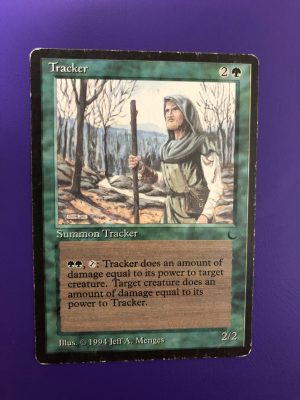
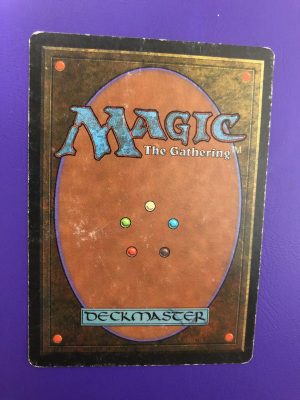
This copy of Tracker is, to me, the ideal outcome when I purchase a heavily played card. Some edge wear, surface wear, and slight deterioration of the corner. I don’t see any creases or inking, which tend to make re-selling a card particularly difficult. All in all, this is the perfect copy for my collection or to sell to another buylist.
Now here’s a different card I received from Star City Games. This one was also sold as heavily played:
When I first examined this card, I was convinced Star City Games had made a mistake! This card is Moderately played at the worst, right? Some edge wear but a very clean surface. But then I noticed it—a weird purple defect on the front face, top left portion of the card. What is that? Inking? Why is it purple? Maybe it’s a misprint or printer defect? That would be cool if it was! But because it’s there, it makes selling this card a bit more complicated. Other vendors may not accept it and I have to highlight the defect to any prospective buyer. This is less than ideal, but I’m happy to include this in my personal collection.
Next, here’s a card I received recently from Card Kingdom, listed in “Good” condition:
This card is rough. Whitening around the edges of the entire card, surface wear, and one edge looks like someone kind of bit down on the card or something! But, because of the broad definition of “Good” on Card Kingdom’s grading guide, this card does indeed fit the category. I’m not too happy with this card’s condition, but the price was right and it’s still an Alpha Blue Elemental Blast—because of this, I don’t think I’ll have any difficulty selling the card.
Next, here’s a heavily played card I recently received from ABUGames:
I deal with heavily played cards from ABUGames a ton. While their near mint prices are astronomically high relative to the market, their played and heavily played copies are sometimes a little closer to reality. This makes such cards prime targets for acquisition when working store credit arbitrage.
This Arabian Nights City of Brass is one of the worst heavily played cards I’ve ever received from ABUGames. Technically it fits their description, but yikes! The card has no folds or inking and is perfectly sleeve playable (in fact it’s in my Old School deck) but it’s not an attractive copy for one’s collection. I would have been more disappointed in this if the card wasn’t priced well (when factoring in the store credit inflation factor).
Lastly, I want to mention one other recent, relevant experience. I don’t have images of the cards, but a few heavily played cards I received from Star City Games recently had some water damage. It wasn’t major (in fact I didn’t even notice it at first) but it was there. I attempted to flip some of these cards to Card Kingdom’s buylist, hoping they would grade as “Good”. But they ended up rejecting the cards altogether and shipping them back to me. I don’t think Card Kingdom allows for water damage in their “good” category, but it’s good to note Star City Games does. I took the damaged cards and shipped them to ABUGames instead—they accept “minor to moderate water damage” as heavily played.
Wrapping It Up
Buying damaged and heavily played cards can be a great way of saving money. Often times I’ll be browsing TCGplayer for cards and I’ll find damaged copies priced significantly below all other available copies. Every time this happens, I pause and think about the damaged lottery.
Most often I pass on the card and move on. It’s impossible to predict what you’ll get! The card could have some light inking and otherwise be flawless…or the card could be bent in half and run through the laundry. The range is so huge for this condition.
For this reason, I stick to major vendors when I deal in damaged and heavily played cards. But even this experience can be extremely variable. Cards can arrive with some major edge wear and not much more. Or the card could be water damaged and may have been inked. Again, the range is huge, and different vendors seem to have variable definitions around what qualifies.
In the end, it’s really a personal choice around what you’re willing to accept and how much of a discount to market price you’re getting for the damaged card. With few exceptions, I pick up heavily played and damaged cards from major vendors because their pricing is extremely competitive—even below what I could sell the card for myself. In these cases, it’s worth the gamble. And as ugly as that City of Brass is, I am still going to play it in my deck.
Everyone’s tolerance for play is different, making the damaged lottery even more complicated. Something unacceptable to one person may be perfectly fine to another, and vice versa. Either way, I don’t think the damaged lottery is going away anytime soon. As long as people are willing to roll the dice to save money, we’ll continue to see damaged cards of all sorts being sold at major discounts.


